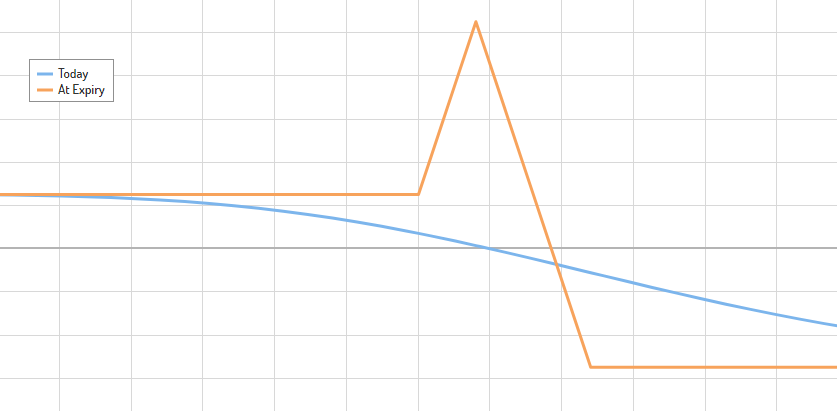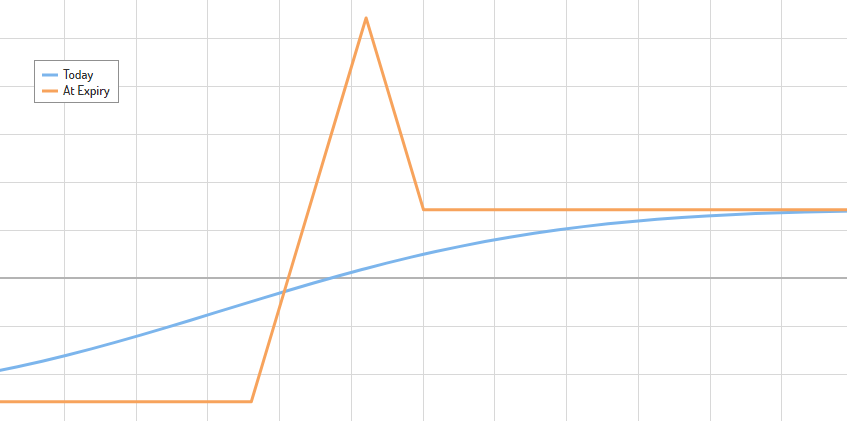Broken Wing Butterfly spreads are a mutated form of normal Butterfly spreads. But they actually work quite differently. Other than normal Butterflies, the broken wing butterfly option trading strategy can even be used for high probability trading. There are different ways to set them up. Here you can learn how they work and how you can set them up. This is an advanced strategy.
Video Lesson
Check out the following video lesson to learn everything you need to know about the broken wing butterfly option strategy:
Check out The Strategy Lab
Call Broken Wing Butterfly

Market Assumption:
Similar to a call credit spread, a call broken wing butterfly strategy is a bearish/neutral strategy. But with a call credit spread, you don’t care if the price of the underlying falls or stays. With a call broken wing butterfly you ideally hope that the price stays right where it is, just like with a normal butterfly spread. Nevertheless, it is not that bad if the price moves further down, with this strategy you still will make money. So as you can see, a call credit spread is a combination of the high probability credit spread strategy and the rather low probability butterfly strategy. This broken wing butterfly spread can be used for high probability trading.
Setup:
- A) Buy 1 (ITM/ATM) Call
- B) Sell 2 (ATM/OTM) Call (1 strike above A)
- Skip one Strike
- C) Buy 1 (OTM) Call (2 strikes above B)
This should result in a credit (You get paid to open), but depending on how far ITM/ATM/OTM you place it, it can result in a debit (pay to open).
Profit and Loss:
As clearly recognizable on the payoff diagram, a call broken wing butterfly is both a defined risk and a defined profit strategy. The maximum achievable profit is usually higher than the maximum loss. But this profit is rarely realized because to achieve it, the price of the underlying has to be exactly at the short strike. This rarely happens. Nevertheless, due to the long call, this strategy will still be profitable, if the price moves further down. Max loss is realized, if the price of the underlying is above the higher OTM long call.
Maximum Profit: Strike of Short Call – Strike of lower Long Call (Width of closer Strikes) (*100) + Premium received – Commissions
If paid to open (debit): Strike of Short Call – Strike of lower Long Call (Width of closer Strikes) (*100) – Premium paid – Commissions
Ex. (Strike 100, 101 and 103) => 1$ Width * 100 + 20$ Premium – 3$ Commissions = 117$ (max profit)
Maximum Loss: Strike of higher Long Call – Strike of skipped Strike (Width of Strikes) (*100) – Premium received + Commissions
If paid to open (debit): Strike of higher Long Call – Strike of skipped Strike (Width of Strikes) (*100) – Premium paid + Commissions
Ex. (Strike 100, 101, and 103) => (103$ -102$) * 100 – 20$ Premium + 3$ Commissions = 83$
(a normal option contract controls 100 shares, therefore *100)
Implied Volatility and Time Decay:
Time Decay or the option Greek Theta is positive and works in the favor of a call broken wing butterfly. If everything goes as planned, the sold options will lose their value over time and eventually expire worthless. The amount of time decay increases, the closer you get to expiration.
This strategy usually profits from a drop in implied volatility (IV) and should therefore ideally be entered in times of high implied volatility (IV rank over 50). Doing this will increase the premium taken in.
Put Broken Wing Butterfly

Market Assumption:
The market assumption for a put broken wing butterfly should be sort of the opposite to the one of a call broken wing butterfly. First priority should again be that the underlying price stays more or less where it already is. But if it moves higher, you can still make some money. Summed up, a put broken wing butterfly is a bullish/neutral strategy. Due to the fact that the price of the underlying has to move before you lose money, this is a suitable strategy for high probability trading.
Setup:
- A) Buy 1 (ITM/ATM) Put
- B) Sell 2 (ATM/OTM) Put (1 strike below A)
- Skip one Strike
- C) Buy 1 (OTM) Put (2 strikes below B)
This should result in a credit (You get paid to open), but depending on how far ITM/ATM/OTM you place it, it can result in a debit (pay to open).
Profit and Loss:
Just as seen on the payoff diagram above, a put broken wing butterfly is both a defined risk and a defined profit strategy. This means that you can’t lose more than a set amount of money. The maximum profit is normally bigger than the maximum draw down. Nevertheless, the max gain is rarely achieved, because to achieve it, the price of the underlying has to be exactly at the strike price of the short puts. But as long as the price does move further up, you still can make some money. Maximum loss is then achieved, when the underlying’s price is below the strike of the lower long put.
Maximum Profit: Strike of higher Long Put – Strike of Short Put (Width of closer Strikes) (*100) + Premium received – Commissions
If paid to open (debit): Strike of higher Long Put – Strike of Short Put (Width of closer Strikes) (*100) – Premium paid – Commissions
Ex. (Strike 100, 99 and 97) => 1$ Width * 100 + 20$ Premium – 3$ Commissions = 117$ (max profit)
Maximum Loss: Strike of skipped Strike – Strike of lower Long Put (Width of Strikes) (*100) – Premium received + Commissions
If paid to open (debit): Strike of skipped Strike – Strike of lower Long Put (Width of Strikes) (*100) + Premium paid + Commissions
Ex. (Strike 100, 99, and 97) => (98$ -97$) * 100 – 20$ Premium + 3$ Commissions = 83$
(a normal option contract controls 100 shares, therefore *100)
Implied Volatility and Time Decay:
Time Decay or the option Greek Theta is positive and works in the favor of a put broken wing butterfly. If everything goes as planned, the sold options will lose their value over time and eventually expire worthless. The amount of time decay increases, the closer you get to expiration.
This strategy usually profits from a drop in implied volatility (IV) and should therefore ideally be entered in times of high implied volatility (IV rank over 50). Doing this will increase the premium taken in.
Trader’s Note:
I personally think that the broken wing butterfly spread is a superb option strategy, which can be very profitable if used correctly. Nevertheless, I do not think that this kind of strategy is for everybody. As you may have noticed in my breakdown of it, the broken wing butterfly option strategy is a very advanced strategy and should therefore also be used by more advanced traders. I do not recommend that any beginner (option) traders use this strategy. For beginners, I would much rather recommend the far simpler credit spread strategy (Learn more about credit spreads here), credit spreads are very simple and work similarly to broken wing butterflies.
Additionally, no matter how advanced you are in trading, if you plan on trading any broken wing butterflies, I recommend only opening them for a credit. If you can’t open your broken wing butterfly for a credit, I suggest either moving the strikes or just moving on to another setup. Opening broken wing butterflies for a credit, will lead to a higher potential profit and an eventual higher probability of success.
The Best Tool to Learn Options Strategies
If you want to learn much more about hundreds of options strategies, I highly recommend checking out The Strategy Lab. The Strategy Lab is a tool designed to help traders understand options strategies, options pricing and the options market in general.

Thanks for writing and explaining this strategy. To be honest, I was pretty lost in the end. You are right to say that this strategy is not for everyone. As I understand this is an advanced strategy, what would you recommend for a beginner to start? Thanks for your Trade Options With Me site. It’s helping me in my road to financial freedom.
Hey and thanks so much for the comment.
For beginners, I would first of all recommend that you educate yourself on options, so you get an idea of what they are and how they work. I have a beginner course on my site for that. You can access it here. Otherwise, I would recommend strategies like Credit and Debit spreads, covered calls etc. for beginners. These strategies all are fairly simple and only consist of one leg (2 different options). But which Strategy you want to trade really depends on your trading style and market assumption. In my intermediate course, I discuss which strategies, I use and when I use them. To learn more about these strategies and others, check out my strategy section here.
What is the exit strategy for this trade if it goes in the wrong direction? What kind of stop protection do you recommend?
Since broken wing butterflies are defined risk strategies, you don’t necessarily have to adjust them if they go against you. I just recommend aiming for 50% of max profit since max profit is rather unlikely. For more adjustment techniques, you could check out my article on options adjustment strategies.
I hope this helps. Otherwise, let me know.
Thanks for your excellent presentation.
Hi Louis,
I never fully understood (or liked) butterfly strategy because I don’t see why we would go through all this hassle (including commissions) to just get a similar outcome of a bull put spread. Instead of 2 short contracts, just do 1 short contract and 1 long put further out for protection, and that’s the same thing with less brain damage. What am i missing?
Thanks,
Hi Tim,
Thanks for your comment. Firstly, a broken wing butterfly has a different payoff profile than a vertical spread. It is basically a butterfly spread with added protection to one side. If you think that XYZ’s stock price will stay right where it is but you aren’t sure whether it might go up or not, a bwb is a much better trade than a vertical spread since it allows you to center the main profit area around the current price and hedge against upside moves. In such a case the risk/reward ratio of a bwb is much better than that of a vertical.
Sometimes, the sensitivity to volatility and time decay can also vary from that of a vertical spread. Furthermore, it isn’t that much more effort to trade a bwb than a vertical.
I hope my example and explanation clarifies some of the differences.
What does (ITM/ATM) and OTM mean? Thanks
In-The-Money, At-The-Money, and Out-of-The-Money. It refers to the option’s strike price in relation to the underlying’s price.